Contents
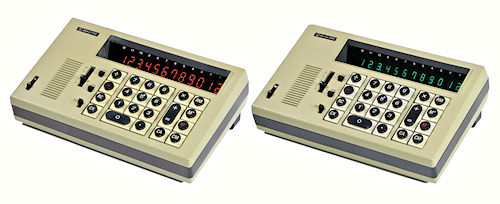
Contents |

|
| Sanyo Models ICC-1122 (1971, left) and ICC-1123 (1973). |
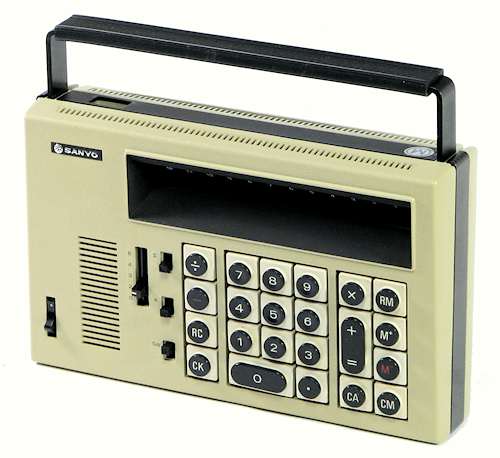 Overview.
Overview.
The Sanyo Electric Company commenced operations in 1947 when founder Toshio Iue acquired a disused Matsushita (later Panasonic) factory through family connections and began making bicycle lamps and generators. The company expanded into domestic appliances and consumer electronics, including radios, televisions, washing machines, and refrigerators. The "ICC-xxx" range of Integrated-Circuit Calculators was introduced in about 1968.
The ICC-1122 and ICC-1123 are two compact desk calculators from the early 1970s. Although they are mains-powered units, the calculators are built in portable cases with substantial carrying handles. They could easily be mistaken for Sanyo's transistor radios from the same period. The same casing was also used for other models, such as the ICC-1418D portable calculator with an internal NiCad battery pack.
Although identical on the outside, the ICC-1122 and ICC-1123 have quite different internal technologies. This page gives a brief description of their construction and operation.
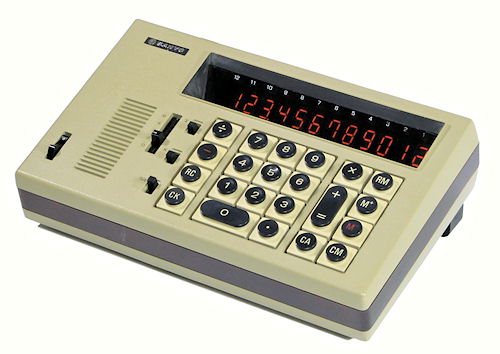 External view.
External view.
The calculators are built in a rectangular plastic casing that is slightly wedge-shaped, with overall dimensions of 220mm wide, 140 deep, and 55 high. Both models weigh about 1.3kg. A dark anodised trim strip separates the top and bottom sections of the case.
The metal carrying handle can be retracted into the top of the case, or folded underneath to act as a stand.
The ICC-1123 was also available with a black case and bright anodised trim.
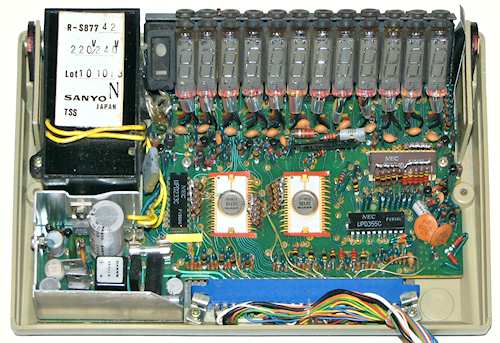 ICC-1122 internal view.
ICC-1122 internal view.
The calculating circuitry is built around two MOS-LSI chips in 42-pin ceramic flat-packs. The part numbers are Sanyo D231B and D232B. There are 4 NEC suport chips (μPD354D, μPD355C, μPD233C, D10A), one Mitsubishi M58217, and a dozen discrete transistors. The double-sided circuit board has several cut tracks and hard-wired "corrections". The keyboard is connected via the edge connector and cable at the front.
The bright 12-digit display uses Sanyo "Eightron" 7-segment gas-discharge tubes (part number SMI-01). The tubes are supported by rubber grommets in a metal frame, and are driven by five Toshiba high-voltage modules (3 x T4105, 2 x T4106) located behind the display.
All of the mains-level wiring is contained within the encapsulated and double-insulated transformer module at the top left. The module incorporates a "figure-8" mains inlet socket at the rear, and a voltage selector which is visible through a window in the underside of the case. The mains input is rated at 220/240V, 8W. The transformer has only a single secondary winding, which feeds an on-board inverter (front left) to generate the logic supplies and the high-voltage supply for the display tubes. The On/Off switch is on the secondary side of the transformer. In keeping with the spirit of the portable design, the detachable mains lead is a good 12 feet long.
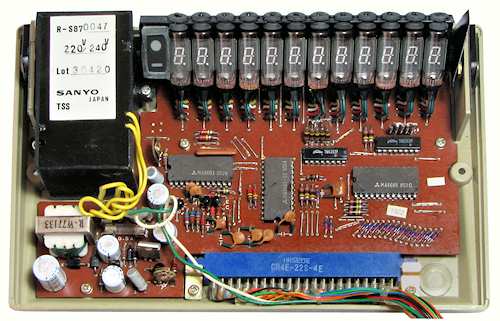 ICC-1123 internal view.
ICC-1123 internal view.
Although the general arrangement of the two machines is very similar, the only common components on the circuit boards are the keyboard edge connector and the over-range indicator at the left of the display.
The circuitry of the ICC-1123 uses three Mitsubishi chips (MA-8603, MA-8604-03, and MA-8605) in 24-pin DIL packages, with 5 smaller support chips and five discrete transistors. The Sanyo gas-discharge display tubes have been replaced with Futaba vacuum fluorescent tubes, type DG10R1.
The power transformer and on-board inverter are similar to those in the ICC-1122, but are different in detail to supply the new logic and display requirements.
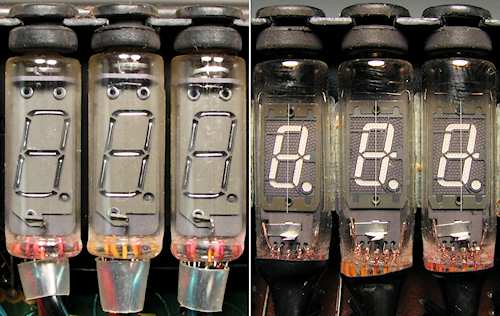 Display tubes.
Display tubes.
On the left are three Sanyo "Eightron" gas-discharge tubes type SMI-01, as used in the ICC-1122. The tubes are 10mm in diameter and 25m tall, with rectangular seven-segment numerals 10mm high.
On the right are three Futaba DG10R1 fluorescent tubes from the ICC-1123. These tubes have the same external dimensions as the Eightron tubes, but the numerals are only 8mm high. The numerals have 8 segments rather than the (now) usual 7, with the extra segment at the centre right used only to display a proper crossed 4.
 Display tube numerals.
Display tube numerals.
The "Eightron" numerals are shown in the top row, with the DG10R1 fluorescent numerals below. Note the extra segment in the lower 4.
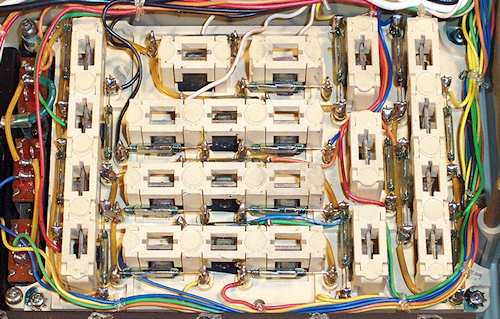 ICC-1122 keyboard construction.
ICC-1122 keyboard construction.
The ICC-1122 keyboard uses glass reed switches operated by moving magnets on the ends of the keystems. The switches are mounted on pins set into a plastic moulding, and are individually hand-wired to the edge connector.
The four slider switches to the left of the keyboard are mounted on the same plastic moulding, which is attached to the underside of the top section of the case. The whole keyboard assembly can be removed as a unit.
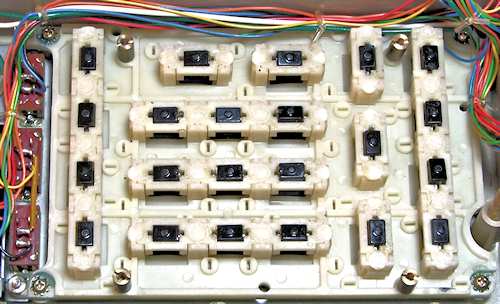 ICC-1123 keyboard construction.
ICC-1123 keyboard construction.
The designers of the ICC-1123 have very cleverly adapted the reed-switch keyboard moulding from the ICC-1122 (above) for use with an elastomeric keysheet and a printed-circuit contact board.
The reed switches and their mounting pins have been removed, but the slots for the pins are still present. The magnets on the keystems have been replaced with small plastic caps. The keysheet and contact board (not shown) are mounted over this assembly on the four round pillars. Cables from the slider switches (left) and the contact board (right) are combined at the top right for connection to the main board edge connector.
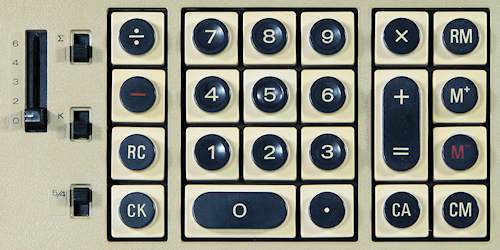
Although the ICC-1122 and 1123 have quite different internal circuitry, they have identical keyboards and operate in essentially the same manner. The operation is quite conventional by modern standards, although (like most early calculators) they do have a couple of peculiarities.
The ICC-1123 has an automatic power-on reset, but the earlier machine requires a manual reset via the CA (Clear All) key.
The memory keys (M+, M-, RM, CM) at the right of the keyboard operate as we have come to expect, but there is no "Memory" indicator in the display.
Addition and subtraction use the Plus/Equals and Minus keys in adding-machine fashion, while multiplication and division use "algebraic" notation. Zero as either divisor or dividend will lock the ICC-1122 with no error indication, whereas on the 1123 division by zero will light the over-range/error indicator.
The red Minus key on the left-hand side generally functions as Minus/Equals, but it can also function as a unary minus (ie, sign change) in some situations. If used at the wrong time it can produce quite unexpected results.
To the left of the keyboard are three small slider switches. The bottom "5/4" switch selects display round-off or truncation. The centre "K" switch enables storing a constant for use in repeated multiplications or divisions. The top "Σ" (sigma or sum) switch automatically accumulates the results of successive multiplications or divisions in the memory.
In multiplication and division, the RC (ReCall) key switches between the current display and the stored multiplicand or divisor. If the value was stored for division, the ICC-1122 displays it left-aligned and filled with trailing zeroes, rather than right-aligned as normal. The ICC-1123 displays all values right-aligned.
The slider switch at the far left sets the number of decimal places in the display to 0, 2, 3, 4, or 6. The decimal position remains fixed in the ICC-1122, but floats within the 12-decade range in the ICC-1123. A lamp to the left of the display indicates overflow.